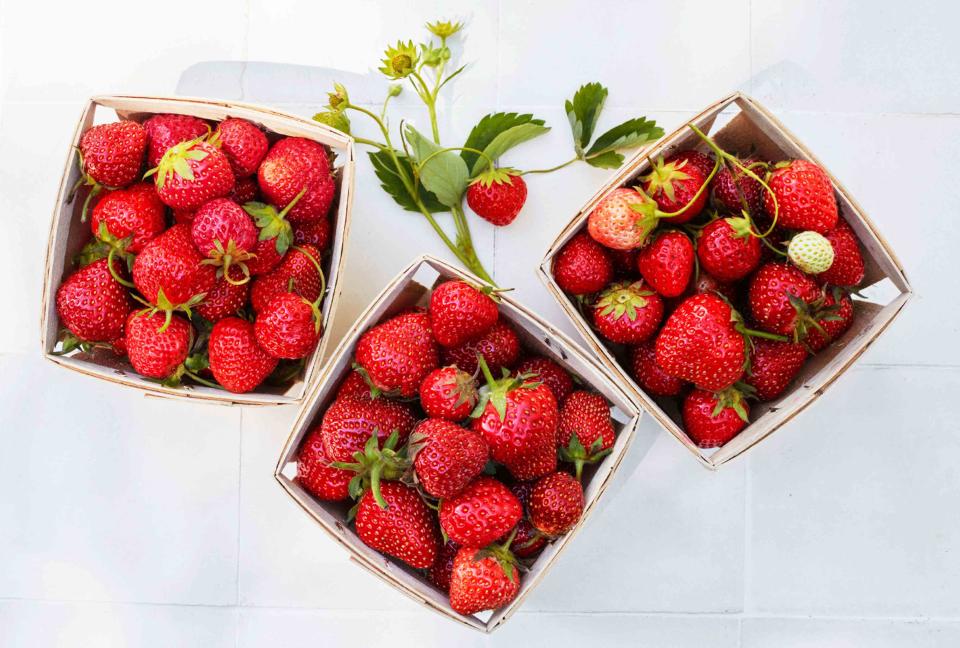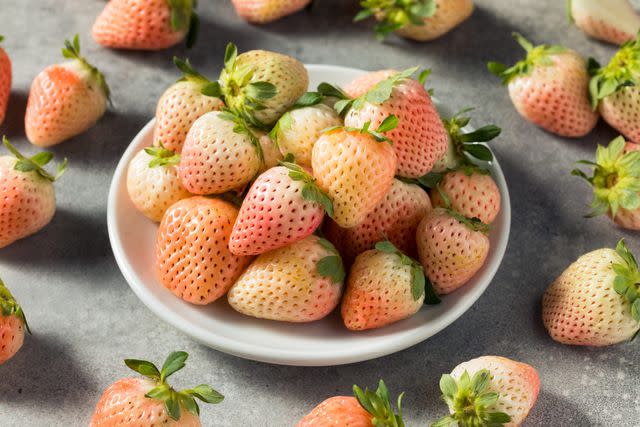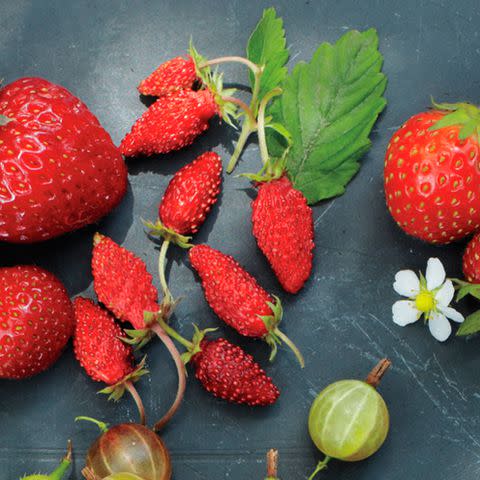14 Common Types of Strawberries—and the Subtle Differences Between Them
Because who doesn't want to eat the best of these juicy berries?

Marcus Nilsson
Universally loved by fruit fans, gardeners, and sweet tooths everywhere, strawberries can turn something as ordinary as a bowl of granola or a smoothie into a cause for celebration. But, what are the best types of strawberries for eating or for using in your favorite dessert recipes? Some strawberries are small and fragile, others plump and juicy—and most are incredibly delicious. We delve into the abundance at our fingertips, from defining characteristics of strawberries to some of the best ways to enjoy these brilliant berries straight from the patch.
Meet Our Expert
Melissa Jones, senior category manager, Misfits Market, an online grocer
Dan Langan, professional pastry instructor and author of Bake Your Heart Out: Foolproof Recipes to Level Up Your Home Baking
Related: How to Wash and Store Berries So They Stay Fresh Longer
Strawberry Classifications
Strawberries are generally grouped into three overarching classifications based on when they flower and fruit.
June-bearing plants: The most common, this strawberry category is available once a year, usually in June. Examples include Allstar, Sequoia, and Chandler.
Everbearing plants: Smaller and less robustly flavored, this category produces crops twice a year, in the spring and fall, and sometimes, an additional harvest in the late spring. Examples include Eversweet and Ozark Beauty.
Day-neutral plants: Considered as sweet as June-bearing plants, this category produces strawberries from June or July through October, flowering and fruiting when the temperatures are moderate. And since they are annuals (vs perennials) they are replanted each year. Examples include Albion, Monterey, and Seascape.
Common Types of Strawberries
There are over 600 varieties of strawberries but most of them are not available to buy as fruit, though they may be available to grow at home. Strawberries are highly perishable, but some are more delicate and prone to spoilage, while others are somewhat sturdier. Sturdier strawberries are the types that are sold in grocery stores because they can withstand shipping and storage. Most are cultivars of Fragaria x ananassa, or the garden strawberry. More delicate varieties are available at farmstands and farmers markets.
Monterey
More than 80 percent of commercial production of strawberries is the Monterey variety (because they are the summer variety and do well with more sunlight), says Jones. Monterey strawberries are hearty, juicy, big, and fragrant.
Albion
A large, juicy, day-neutral, everbearing hybrid—these berries are noted for their conical shape and sweet flavor. On the retail side of the fence, Melissa Jones, senior category manager at Misfits Market, notes that Albion, Allstar, and Diamonte varieties are less well-known than Monterey and are a bit softer.
Allstar
An easy-to-grow June-bearing strawberry that is glossy, sweet, and juicy with a mildly tart undertone. Along with Albion and Diamante, Allstar doesn't pack quite as well as Monterey, says Jones, so you're more likely to find them if a local producer raises them—or you can grow them at home.
Diamante
Another day-neutral, pastry chef and teacher Dan Langan, author of Bake Your Heart Out, finds that Diamante's key characteristics work well for some sweets in particular. "Diamante strawberries tend to be exceptionally plump and bright, making them a great choice to use in desserts where they're presented whole," he says. "Think chocolate-covered strawberries piled high atop a layer cake."
Honeoye
Langan says Honeoye is a good option for eating fresh, preserving, and incorporating into fruit tarts. Large and sweet, it's another June-bearing hybrid and a solid choice for home growers, he says.
Specialty Strawberries

More growers are developing their own proprietary varieties and selling them by name at the grocery store, says Jones. She mentions Wish Pink-A-Boo and Driscoll's Tropical Bliss as examples.
Pineberry
A standout among strawberries, says Jones, is the Pineberry. It's a white strawberry cultivar with pink seeds and a pineapple-ish flavor.
Koyo Berry
Another variety worth seeking out is the Koyo Berry. This tart, bright red berry is a proprietary variety from the innovative vertical farming company Oishii.
Sweetest Batch
A bright red specialty berry from Driscoll's, this strawberry is juicy and extra sweet with almost a fruit punch or strawberry candy flavor.
Wild Strawberries

Marcus Nilsson
Older than the garden strawberry is Fragaria vesca, or wild strawberry. It is a species of strawberry plant native throughout the Northern Hemisphere and has many names, including woodland strawberry, wood strawberry, and wild strawberry. You may also know it as fraises des bois or alpine strawberry. Its berries are much smaller than the popular cultivars but its flavor is big. Alpine strawberries are sometimes available at farmstands or farmers markets.
Best Strawberries for Desserts and Baking
Following are some of the top choices for strawberries that are great for making baked goods and other sweet treats.
Sparkle Strawberries
For jams or preserves, Langan finds that Sparkle, an heirloom variety, is a great go-to. “Sparkle strawberries are available during the June harvest and boast a flavor that holds up well to cooking and preserving," says Langan. They're also freezer-friendly. "These plump strawberries also do well when frozen so that you can stash away some goodness for later on.” As in breakfast treats like scones and muffins.
Other baking stalwarts include:
Baron Solemacher: Big and juicy (think Strawberry Shortcake).
Camarosa: Sweet, huge, and delicious in Strawberry Crepes.
Earlglow: A reliable berry for cakes.
Blakemore: A tart option for strawberry pies.
Best Strawberries for Eating
While some strawberries are better for baking than others, the good news is that most are delightful to eat fresh, says Jones. Langan agrees, saying, "I'd happily enjoy a freshly harvested strawberry, no matter the variety."
All of the strawberries listed here are delicious, but standouts include fraise des bois, Albion, and Allstar, which all have great flavor.
Buying and Prepping Strawberries
When shopping for strawberries, Langan keeps an eye out for berries that are large and deep red. He also checks for a bright aroma which indicates the berries will be flavorful.
"If I plan to use whole berries as a garnish, I'll choose strawberries with bright and delicate leaves that'll show nicely on my dessert," he says.
When you're ready to devour them (and not before), rinse, remove the leafy green cap (if preferred), slice, and enjoy. Add fresh strawberries to fruit salads, yogurt, or cereal, or top them with a dollop of whipped cream or crème fraîche for a no-fuss dessert.
If your strawberries have turned the corner, all is not lost. "Once they start to get soft, or show a little bit of decay (yes, I said decay), you can freeze them or turn them into jam." says Jones.
Read the original article on Martha Stewart.

